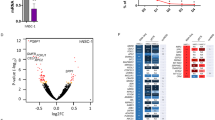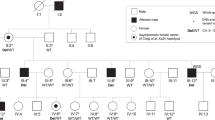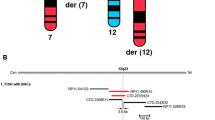Abstract
X-linked mental retardation has been traditionally divided into syndromic (S-XLMR) and non-syndromic forms (NS-XLMR), although the borderlines between these phenotypes begin to vanish and mutations in a single gene, for example PQBP1, can cause S-XLMR as well as NS-XLMR. Here, we report two maternal cousins with an apparently X-linked phenotype of mental retardation (MR), microphthalmia, choroid coloboma, microcephaly, renal hypoplasia, and spastic paraplegia. By multipoint linkage analysis with markers spanning the entire X-chromosome we mapped the disease locus to a 28-Mb interval between Xp11.4 and Xq12, including the BCOR gene. A missense mutation in BCOR was described in a family with Lenz microphthalmia syndrome, a phenotype showing substantial overlapping features with that described in the two cousins. However, no mutation in the BCOR gene was found in both patients. Subsequent mutation analysis of PQBP1, located within the delineated linkage interval in Xp11.23, revealed a 2-bp deletion, c.461_462delAG, that cosegregated with the disease. Notably, the same mutation is associated with the Hamel cerebropalatocardiac syndrome, another form of S-XLMR. Haplotype analysis suggests a germline mosaicism of the 2-bp deletion in the maternal grandmother of both affected individuals. In summary, our findings demonstrate for the first time that mutations in PQBP1 are associated with an S-XLMR phenotype including microphthalmia, thereby further extending the clinical spectrum of phenotypes associated with PQBP1 mutations.
Similar content being viewed by others
Log in or create a free account to read this content
Gain free access to this article, as well as selected content from this journal and more on nature.com
or
References
Stevenson RE : Splitting and lumping in the nosology of XLMR. Am J Med Genet 2000; 97: 174–182.
Raymond FL : X-linked mental retardation: a clinical guide. J Med Genet 2006; 43: 193–200.
Ropers HH, Hamel BC : X-linked mental retardation. Nat Rev Genet 2005; 6: 46–57.
Frints SG, Froyen G, Marynen P, Willekens D, Legius E, Fryns JP : Re-evaluation of MRX36 family after discovery of an ARX gene mutation reveals mild neurological features of Partington syndrome. Am J Med Genet 2002; 112: 427–428.
Kleefstra T, Hamel BC : X-linked mental retardation: further lumping, splitting and emerging phenotypes. Clin Genet 2005; 67: 451–467.
Frints SG, Froyen G, Marynen P, Fryns JP : X-linked mental retardation: vanishing boundaries between non-specific (MRX) and syndromic (MRXS) forms. Clin Genet 2002; 62: 423–432.
Kalscheuer VM, Freude K, Musante L et al: Mutations in the polyglutamine binding protein 1 gene cause X-linked mental retardation. Nat Genet 2003; 35: 313–315.
Kleefstra T, Franken CE, Arens YH et al: Genotype–phenotype studies in three families with mutations in the polyglutamine-binding protein 1 gene (PQBP1). Clin Genet 2004; 66: 318–326.
Lenski C, Abidi F, Meindl A et al: Novel truncating mutations in the polyglutamine tract binding protein 1 gene (PQBP1) cause Renpenning syndrome and X-linked mental retardation in another family with microcephaly. Am J Hum Genet 2004; 74: 777–780.
Fichera M, Falco M, Lo Giudice M et al: Skewed X-inactivation in a family with mental retardation and PQBP1 gene mutation. Clin Genet 2005; 67: 446–447.
Stevenson RE, Bennett CW, Abidi F et al: Renpenning syndrome comes into focus. Am J Med Genet A 2005; 134: 415–421.
Abidi FE, Holloway L, Lubs H, Meindl A, Stevenson RE, Schwartz CE : Golabi-Ito-Hall syndrome results from a missense mutation in the WW domain of the PQBP1 gene. 54th Annual Meeting of the American Society of Human Genetics, Toronto, Canada, 2004.
Cossee M, Demeer B, Blanchet P et al: Exonic microdeletions in the X-linked PQBP1 gene in mentally retarded patients: a pathogenic mutation and in-frame deletions of uncertain effect. Eur J Hum Genet 2006; 14: 418–425.
Martinez F, Martinez-Garay I, Oltra S et al: Localization of MRX82: a new nonsyndromic X-linked mental retardation locus to Xq24-q25 in a Basque family. Am J Med Genet A 2004; 131: 174–178.
Lenz W : [Recessive, sex-limited microphthalmia with multiple abnormalities]. Z Kinderheilkd 1955; 77: 384–390.
Ng D, Thakker N, Corcoran CM et al: Oculofaciocardiodental and Lenz microphthalmia syndromes result from distinct classes of mutations in BCOR. Nat Genet 2004; 36: 411–416.
Horn D, Chyrek M, Kleier S et al: Novel mutations in BCOR in three patients with oculo-facio-cardio-dental syndrome, but none in Lenz microphthalmia syndrome. Eur J Hum Genet 2005; 13: 563–569.
Lejeune F, Maquat LE : Mechanistic links between nonsense-mediated mRNA decay and pre-mRNA splicing in mammalian cells. Curr Opin Cell Biol 2005; 17: 309–315.
Hamel BC, Mariman EC, van Beersum SE, Schoonbrood-Lenssen AM, Ropers HH : Mental retardation, congenital heart defect, cleft palate, short stature, and facial anomalies: a new X-linked multiple congenital anomalies/mental retardation syndrome: clinical description and molecular studies. Am J Med Genet 1994; 51: 591–597.
Laumonnier F, Bonnet-Brilhault F, Gomot M et al: X-linked mental retardation and autism are associated with a mutation in the NLGN4 gene, a member of the neuroligin family. Am J Hum Genet 2004; 74: 552–557.
Bachoo S, Gibbons RJ : Germline and gonosomal mosaicism in the ATR-X syndrome. Eur J Hum Genet 1999; 7: 933–936.
Mari F, Caselli R, Russo S et al: Germline mosaicism in Rett syndrome identified by prenatal diagnosis. Clin Genet 2005; 67: 258–260.
Satre V, Monnier N, Berthoin F et al: Characterization of a germline mosaicism in families with Lowe syndrome, and identification of seven novel mutations in the OCRL1 gene. Am J Hum Genet 1999; 65: 68–76.
Zlotogora J : Germ line mosaicism. Hum Genet 1998; 102: 381–386.
Forrester S, Kovach MJ, Reynolds NM, Urban R, Kimonis V : Manifestations in four males with and an obligate carrier of the Lenz microphthalmia syndrome. Am J Med Genet 2001; 98: 92–100.
Hoefnagel D, Keenan ME, Allen Jr FH : Heredofamilial bilateral anophthalmia. Arch Ophthalmol 1963; 69: 760–764.
Ng D, Hadley DW, Tifft CJ, Biesecker LG : Genetic heterogeneity of syndromic X-linked recessive microphthalmia-anophthalmia: is Lenz microphthalmia a single disorder? Am J Med Genet 2002; 110: 308–314.
Acknowledgements
We express our gratitude to the family for their active collaboration in the present study. We thank Inka Jantke for skillful technical assistance. This work was supported by Grants G03/098 and FIS04/0425 (Fondo de Investigación Sanitaria) from the Spanish Ministry of Health, as well as EC, QLG2-CT1999-00791 from the European Union.
Author information
Authors and Affiliations
Corresponding author
Rights and permissions
About this article
Cite this article
Martínez-Garay, I., Tomás, M., Oltra, S. et al. A two base pair deletion in the PQBP1 gene is associated with microphthalmia, microcephaly, and mental retardation. Eur J Hum Genet 15, 29–34 (2007). https://doi.org/10.1038/sj.ejhg.5201717
Received:
Revised:
Accepted:
Published:
Issue date:
DOI: https://doi.org/10.1038/sj.ejhg.5201717
Keywords
This article is cited by
-
Changes in the folding landscape of the WW domain provide a molecular mechanism for an inherited genetic syndrome
Scientific Reports (2016)
-
Mutations in the PQBP1 gene prevent its interaction with the spliceosomal protein U5–15kD
Nature Communications (2014)
-
BCOR analysis in patients with OFCD and Lenz microphthalmia syndromes, mental retardation with ocular anomalies, and cardiac laterality defects
European Journal of Human Genetics (2009)



